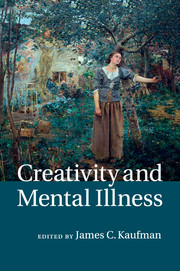Book contents
- Frontmatter
- Dedication
- Contents
- List of figures
- List of tables
- List of contributors
- Preface
- Acknowledgments
- Part I Creativity and mental illness: the state of the field
- 1 A socio-historical overview of the creativity–pathology connection: from antiquity to contemporary times1
- 2 The mad (creative) genius: what do we know after a century of historiometric research?
- 3 Reviewing recent empirical findings on creativity and mental illness
- 4 Building connections on sand: the cautionary chapter
- Part II Cognitive and neuroscientific perspectives on creativity and mental illness
- Part III Creativity and the spectrum of mental illness
- Part IV Creativity and mental illness: possible commonalities
- Part V Creativity and mental health
- Part VI Creativity and mental illness: what now?
- Index
- References
4 - Building connections on sand: the cautionary chapter
from Part I - Creativity and mental illness: the state of the field
Published online by Cambridge University Press: 05 August 2014
- Frontmatter
- Dedication
- Contents
- List of figures
- List of tables
- List of contributors
- Preface
- Acknowledgments
- Part I Creativity and mental illness: the state of the field
- 1 A socio-historical overview of the creativity–pathology connection: from antiquity to contemporary times1
- 2 The mad (creative) genius: what do we know after a century of historiometric research?
- 3 Reviewing recent empirical findings on creativity and mental illness
- 4 Building connections on sand: the cautionary chapter
- Part II Cognitive and neuroscientific perspectives on creativity and mental illness
- Part III Creativity and the spectrum of mental illness
- Part IV Creativity and mental illness: possible commonalities
- Part V Creativity and mental health
- Part VI Creativity and mental illness: what now?
- Index
- References
Summary
There is a widespread and long-running belief that great talent and great psychopathology are closely related; it dictates that no one receives the gift of genius without the curse of depression, and probably mania as well. But the truth is this: There is no hard proof that highly creative people are more susceptible to mental disorder than anybody else. Despite centuries of professional attention, the link between creativity and madness (C&M) remains more stereotype than science.
In the absence of compelling empirical evidence, C&M advocates have had to assemble their argument from other sources. These include weak studies that are cited more often than they are read, and acquire their clout from repetition, rather than valid results; the (mis-)reported opinions of Greek philosophers; melodramatic literary accounts of creative ecstasy and anguish; and lists of geniuses who are diagnosed after death, mostly from second- and third-hand reports from their contemporaries (data which, in other settings, would be known simply as “gossip”).
- Type
- Chapter
- Information
- Creativity and Mental Illness , pp. 60 - 76Publisher: Cambridge University PressPrint publication year: 2014
References
- 8
- Cited by

